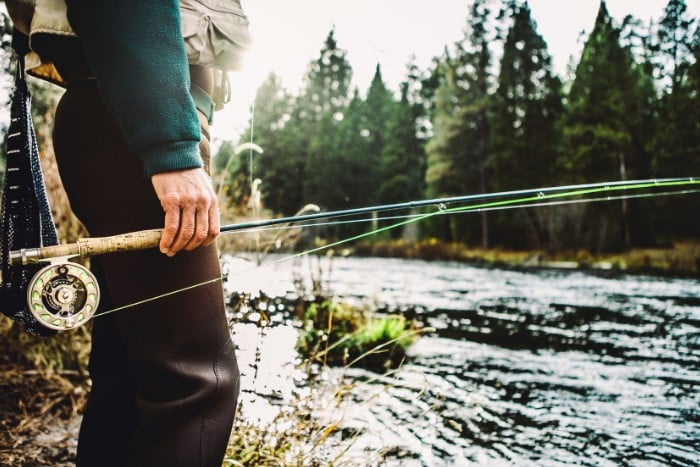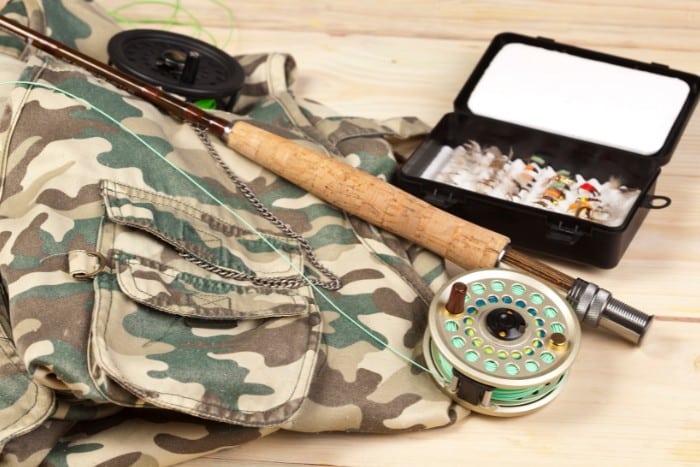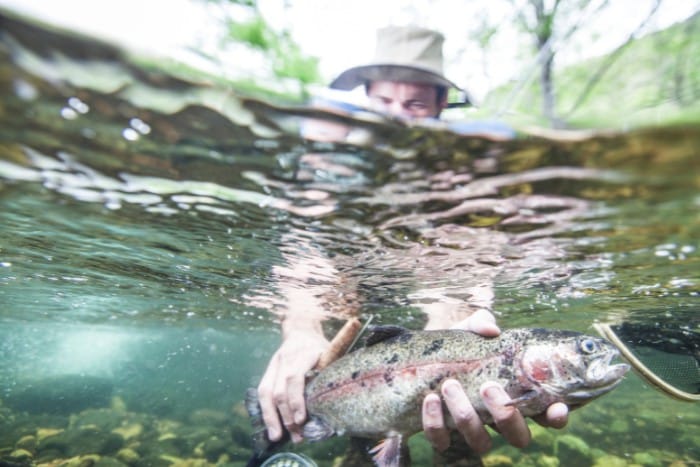For anglers across the world, trout are a highly sought-after fish. Over the years, more methods and techniques have been developed to help anglers land these finicky fish. Rod and reel and fly fishing are the two primary methods anglers use to land these fish.
Fly fishing is the best type of fishing for trout. A trout’s primary food source is insects, so the artificial flies used in fly fishing give anglers the best chance at landing one. Fly fishing can be challenging but allows anglers to connect with trout and learn their habits.
Fly fishing for trout is a lifelong hobby that anglers can spend years trying to master.
Why Fly Fishing is Best for Trout?
As mentioned earlier, trout primarily eat insects. When fly fishing, anglers use insect representations that dive into the water and sit on top of the water.
These can imitate a nymph (a hatching insect without wings) and an adult insect (a fully developed insect with wings).
Using a fly rod allows anglers to cast these flies into tight conditions and have them drop into or onto the water like they naturally would. Also, a fly rod gives anglers complete control of their bait.
The longer rod, fly line, leader, and tippet setup allows anglers to cast their fly into/onto the water and make mends, also known as adjustments, to get the flies into the proper position.
It’s important that flies drift in the current or get stripped or reeled in naturally. If the fly imitations do not look natural, trout will not eat them.
Fly rods are created for anglers to adjust their fly’s position at any time. Fly rods are also better because of the casting opportunities they present.
Regular spinning rods struggle to cast the light flies onto or into the water because a single casting motion isn’t going to be enough to get the flies farther out into the water.
The momentum created through the false casting motion of a fly rod allows anglers to make up to 70 or 80-foot casts.
Flies can also imitate crustaceans as well as bait fish. These flies are traditionally called “streamers.”
Anglers can use the extra momentum from the weight of the fly to get it far out into the water and let it sink.
Regardless of what type of bait you want to use, there will be a “fly” that represents it. These flies are generally barbless, so eating them is healthier for the fish.
If you want to have a look at what other baits you can use to fish trout, please read my article on the same.

A Simple Fly Fishing Setup for Trout
Generally, trout aren’t going to be overly large. The average size for a trout is right around 15 or 16 inches. As a result, anglers don’t have to use overly heavy fly fishing equipment to target them.
Fly Rod
For a trout fishing fly rod, anglers have a few things to consider: weight, length, and action.
1. Weight
- A good trout fishing rod is anywhere between a 3-weight and a 6-weight.
- 3-weights and 4-weights are ideal for smaller streams and areas with smaller fish.
- 5-weights and 6-weights are good choices for medium- and large-sized rivers and lakes.
2. Length
A good rod length is anywhere between 7′ to 11′.
A 7′ or 8′ foot rod should be used in those tight conditions where casting lanes are small, and you need to fit your fly into a tight window.
The 7′ and 8′ rods may not have as much leverage, but they’re long enough for you to land the majority of fish you find.
Anywhere between an 8′ or 9′ rod is fine for larger, more open bodies of water. The longer rod allows you to make longer casts and have more power if you hook into a larger fish.
That will give you a good fight. Plus, these rods are perfect for fishing with dry flies and nymphs.
Dry flies can be difficult to drop softly on the water, and the added length of the rod does well to have the line unfurl onto the water.
A 10′ or 11′ rod is usually reserved for Euro Nymphing.
Euro Nymphing is when anglers use the length of the rod to stick their fly far out into the areas holding fish and have the only thing touching the water be their fly, tippet, and leader.
Anglers who fish smaller streams Euro Nymph.
3. Action
A fast-action rod is good for big water, large fish, and tougher weather conditions. You aren’t going to get as much flex in the rod, and you have all the power you need to fight.
A moderate or moderate fast action rod provides some of the power of fast action and some sensitivity. The sensitivity can be nice for smaller water or the days when you’re fishing with smaller flies.
A slow-action rod is great for dry flies. You have ultimate control of your flight. However, you will lack some power, so keep that in mind.
Also, I have written a whole article on reliable trout fishing rod recommendations which you might want to check out. It talks about spinning rod recommendations though.
Fly Reels
The reel you need is entirely dependent on the size of rod you’re using. For example, if you’re fishing with a 6-weight rod, you’re going to want to fish with a 6-weight reel.
If you’re fishing with a 4-weight rod, you want a 4-weight reel. It’s important to use similar weighted reels and rods to ensure a properly balanced setup.
Check out my fly fishing reel recommendations to find out about the best ones.
Fly Line, Leader, and Tippet
Once you have your rod and reel, the final things to secure are your fly line, leader, and tippet.
1. Fly Line
You want your fly line to match the weight of your rod and reel. So, a 6-weight rod and reel would require a 6-weight fly line. You can use a floating or sinking line depending on how and where you’re fishing.
If you’re fishing deep water for subsurface fish, you may want a sink tip line. If you’re fishing rivers or for fish feeding on the surface, a floating line is a good choice.
2. Leader
The size and type of leader you use is also dependent on the style of fishing. If you’re throwing streamers, a 0x or 1x 7’ leader is strong enough to handle hard strikes from fish.
If you’re throwing nymphs or dries, a 3x or 4x 9’ leader is a good choice.
3. Tippet
Tippet is the final piece to your fly fishing setup. Tippet is an extremely thin monofilament line that is nearly impossible for the fish to see.
It’s smart to use it when you’re throwing dry flies or nymphs in extremely clear water. For trout, a 3x-6x tippet does the trick.

Reading Water When Fly Fishing for Trout
Fly anglers need to know how to read the water they’re fishing.
Trout sit in specific areas in lakes and rivers; if you can’t locate these more “fishy” areas, you may struggle to land as many fish as you would like.
Overall, trout are going to go where they find food. So, whether it’s an evening hatch of insects or a large group of crustaceans, start by trying to identify food, and then work your way to the areas listed below.
Rivers
When looking at a river, look for slow-moving water. It could be a small pocket of slow water in a rushing rapid or a deep pool at the end of some riffles.
Trout don’t want to waste all of their energy fighting against a fast current. They want to sit in slower water and save their energy for pursuing food.
Also, look for a cover or structure. The cover or structure can look like anything from fallen trees to large boulders.
Trout want a safe place to retreat to after they’re done feeding or if they see a predator. If you can find slow-moving water and cover, you have a great chance to catch a trout.

Lakes
In lakes, structure and cover are the most important things. Trout will follow the food, so as long as they know they’re protected, they’ll feed just about anywhere in the water column.
In lakes, fallen trees or rocks close to shore are great places to spend time looking. Otherwise, drop-offs with trees or boulders that are falling down are good places to look for holding trout.
Conclusion
Trout are an absolute blast to catch. They generally live in beautiful areas with crystal clear water and picturesque views. Plus, they always present a challenge.
Their feeding habits can change, so it’s up to the angler to be able to figure out the puzzle. Use a fly rod and some flies that match the local insects when fishing for trout.
Fly fishing is a unique skill that can always be perfected just a bit more. With patience and a willingness to learn, you’ll have a lifetime of opportunities to land fish.
